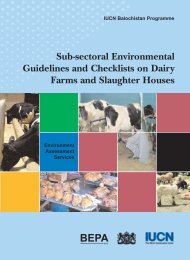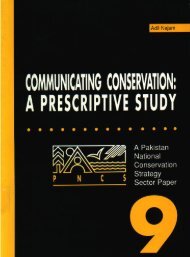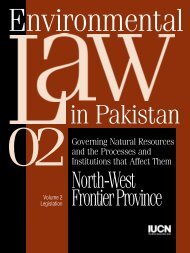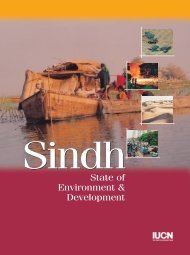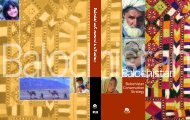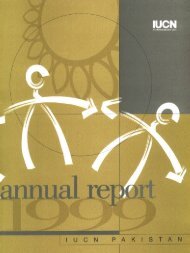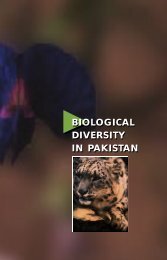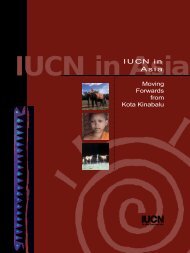Sustainable Fisheries - Pakistan Water Gateway
Sustainable Fisheries - Pakistan Water Gateway
Sustainable Fisheries - Pakistan Water Gateway
Create successful ePaper yourself
Turn your PDF publications into a flip-book with our unique Google optimized e-Paper software.
field of limnology and biology of fish in<br />
reservoirs needs to be done. Such data<br />
should then be used for more precise planning<br />
of reservoir fishery development.<br />
Aquaculture<br />
<strong>Pakistan</strong> has a sizeable area of land and water<br />
suitable for the development of aquaculture<br />
along the coastline, in the estuarine areas and<br />
in the flood plains where many species of<br />
shrimp and fish can be cultured. There is also<br />
scope for the establishment of rearing farms for<br />
the commercial production of fish and shrimp in<br />
both fresh and marine waters. This needs to be<br />
complemented by a comprehensive extension<br />
programme with incentives and subsidies for the<br />
promotion of the industry.<br />
Stocking Public <strong>Water</strong>s/Utilization of<br />
Wetlands<br />
Stocking fish in commonly owned water bodies<br />
in villages and town (village ponds, etc.) can<br />
play a significant role in fish production for the<br />
poor, especially in inland areas. This would considerably<br />
improve the nutritional value of the<br />
diet of poorer sections of society. Poor villages,<br />
particularly in the remote areas, should be given<br />
priority by the government when stocking is<br />
being considered. Subsequent management<br />
should be handed over to a village management<br />
committee. The fish should be harvested at<br />
a particular time of the year followed by immediate<br />
restocking. The product should be sold to<br />
the public at subsidized rates. The government<br />
should fund the project completely in the first<br />
and second years, 50% in the third and fourth<br />
years and upto 25% in the fifth year. Thereafter,<br />
the government should provide only technical<br />
advice. This use will add a new dimension to<br />
community resources generally used for washing<br />
clothes, and for the bathing of both human<br />
beings and cattle. The Punjab government has<br />
started such a pilot project in a village and the<br />
lessons learnt from this can provide guidelines<br />
for the future.<br />
The right approach would be to prepare a<br />
map of stockable waters and overlay this with a<br />
map showing areas of extreme poverty in order<br />
to estimate where the benefits, in terms of nutrition,<br />
will be the most.<br />
Mangroves: Designation of Areas for<br />
Conservation<br />
Although biosphere reserves have been designated<br />
for terrestial forests and plantations, no<br />
such reserves have as yet been created for<br />
mangroves.<br />
Mangrove forests provide a link between<br />
marine and terrestial ecosystems. There is generally<br />
an import of nutrients from the land to<br />
the mangroves, and then an export of nutrients<br />
from the mangroves to the sea. In the mangrove<br />
swamps most primary production is by<br />
the trees.<br />
Coast Conservation Department<br />
A coastal zone management plan should be formulated<br />
through the creation of a Coast Conservation<br />
Department. The following objectives,<br />
with respect to estuaries, lagoons and mangroves<br />
should be kept in mind.<br />
● To safeguard the coast to protect these<br />
ecosystems.<br />
● To enhance fishery production from these<br />
ecosystems.<br />
● To utilize these ecosystems for mineral<br />
extraction in a manner that does not conflict<br />
with the above points.<br />
National Conservation Databank<br />
A national conservation databank project should<br />
be established at the federal level to facilitate<br />
the analyses, interpretation and dissemination of<br />
data on various aspects pertaining to the conservation<br />
of sectors identified by the NCS. This<br />
database should link with an international<br />
database.<br />
In the past, fisheries managers have accorded<br />
the economic and social aspects of their work<br />
a lower priority than biological data collection.<br />
Today, the need is for multi-disciplinary data for<br />
decision-makers.<br />
NCS SECTOR PAPER 25




